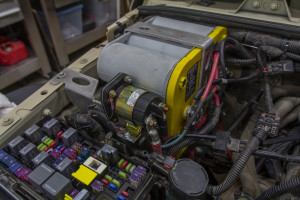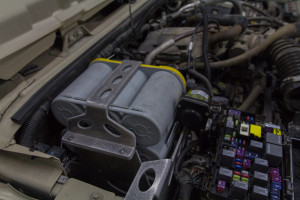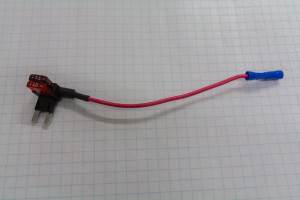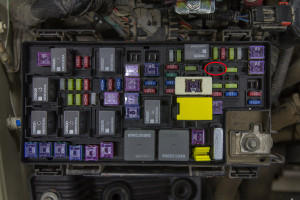Isolated dual batteries are a must in any Overland vehicle. The setup looks complicated and difficult in photos, though it’s actually very simple. Having two batteries means one can be used only to start the vehicle (let’s call this battery the “Engine Battery”) and the other can be used for all your electrical needs like a fridge, camp lights, charging of devices, running an inverter etc. (Let’s call this battery the “House Battery”). The isolation part refers to how the batteries are connected and disconnected with the engine is running and when the engine is not.
When the engine is running, we want the batteries to be connected in parallel (positive to positive, negative to negative) so we still get 12V, and the alternator can charge both batteries.
When the engine is not running, we want to separate the batteries, so that if the House Battery is completely discharged, the Engine Battery remains unaffected and will still start the vehicle engine without issue.
This “isolator” is commonly a large amperage solenoid that is triggered with an ignition hot wire.
Things To Consider
- Because the two batteries will be connected in parallel when the engine is running, it’s highly recommended to use two identical batteries to ensure even charging from the alternator.
- A cheap solenoid might save $30 now, though given it’s the fundamental piece of the puzzle, I recommend buying a good one that will last a very long time
- The system described here does nothing to prevent excessive discharging of the House Battery – if you leave multiple big camp lights on overnight, your house battery will completely discharge, which is usually not good for the longevity of the battery so you want to avoid this at all costs. Make sure you turn your electronics off, and/or buy devices with a voltage cutoff (i.e. my Dometic CFX-35 Fridge has a setting that will turn the fridge off when it senses the House Battery is too low)
Things To Buy
- Two Batteries. I use and recommend Optima’s YellowTop D34. They are specifically designed to handle the kind of charging and discharging the House Battery is going to go through. As a bonus they can be mounted on the side which is a win in the cramped JK engine bay and opens up all kinds of mounting options
- A dual battery tray. I have the Nemesis Industries tray which is specifically designed for the Optima D34 batteries. The batteries mount on their side, saving previous space.
- A solenoid for isolation. I’m running a kit from Painless Performance specifically designed for this purpose, and it’s excellent. (Note the Painless kit comes with everything you need, and a switch so you can control when the batteries are connected. The following instructions will not use that switch so they’re generic for all solenoids)
- Heavy gauge wire to connect the batteries, welding wire with crimps already on the ends works great for this. You’ll need one black wire to connect the two negative terminals together, and two red wires to connect the two batteries to the solenoid.
- Battery terminals for the House Battery. I really like the kind that have a large post for connecting the wires of all the accessories I’m running
- A mini add-a-circuit fuse holder – we’ll stick this in the JK fuse block to trigger the solenoid when the engine is running
- Zip ties to keep everything tidy
- Depending on what came with you solenoid, you might need to make a bracket to mount it. I used a scrap piece of a right angle bracket I had left over from something else.
Tools Needed
Only basic tools, though the specifics will depend on which dual battery try you use. You really won’t need more than a ratchet and extension bar, a few sockets (at least 1/2 inch and 10mm), some kind of saw to cut plastic (hand or electric is fine).
A deep 10mm socket is handy.
Step 1:
Follow the instructions that came with your dual battery tray to remove your existing battery and the large factory plastic tray, and install the new dual battery tray. Usually this involves cutting the factory plastic tray.
Step 2:
Install the two batteries in the tray – when using the Nemesis Industries tray it’s recommended to install the Hose Battery on the bottom, and the Engine Battery on the top. If your tray mounts the batteries side-by-side or front-and-back, check how well the stock jeep wires for the positive and negative will reach each location. Whichever battery suits those wires the best can be your Engine Battery.
Step 3:
Connect the negative terminal of both batteries directly together. These will always be connected with large gauge wire, and never need to be disconnected.
Step 4:
Find a good spot to mount the solenoid. You’re going to run heavy positive wires to the large terminals from each battery, so keep it close to the batteries. Check hood clearance, and make sure neither terminal will touch any part of the body nor hood.
Step 5:
Install the min add-a-circuit fuse holder in the JK fuse block in the location indicated on the picture below. This will trigger the solenoid to turn on when the engine is running. Drill a hole just big enough for the wire in the bottom/side of the JK fuse block cover, feed the wire through and put silicon around it to seal the hole from dust and water.
Connect the other end to the small trigger terminal on the solenoid.
Step 6:
Connect the other small terminal on the solenoid to an earth – this could be the negative of either battery, or the body of the Jeep. Remember, they’re all connected together now, all the tire, so it doesn’t matter what you use, it’s all the same thing.
Step 7:
Connect one heavy gauge red wire onto the positive of each battery, and to each of the large terminals on the solenoid.
Step 8:
Connect all your accessories (fridge, lights, etc) to the House Battery positive and negative.
Step 9:
Connect all the stock Jeep wires onto the Engine Battery positive, and then lastly connect the stock Jeep wires to the negative of the Engine Battery. Leaving the negative until last ensures you won’t get a really big spark if you accidentally touch something to the body during the whole setup.
Step 10:
Zip tie wires together and out of the way, and attempt to make everything as neat as possible, which is not easy.
Step 11:
Test out your new isolated dual battery setup – When you start the engine you will hear a “clunk” as the solenoid connects the two batteries. You will hear the same “clunk” when you turn the engine off again.
Enjoy hours of lights and icy cold beverages without worry of draining your Engine Battery!
-Dan Grec
The Road Chose Me






